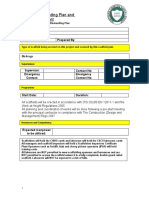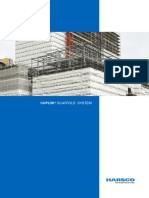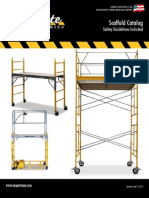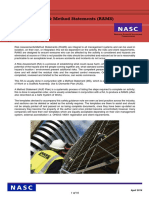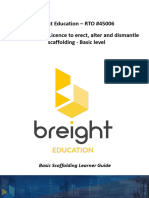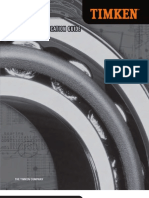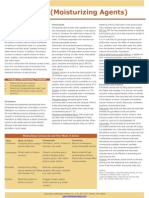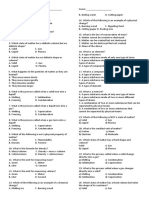0 ratings0% found this document useful (0 votes)
466 viewsScaffoldCouplers14
ScaffoldCouplers14
Uploaded by
Guatemalan1979This document provides information on various types of scaffold couplers used to assemble scaffolding according to Australian standards. It describes common couplers like double couplers, swivel couplers, and reduction couplers that join scaffold tubes at right angles or any angle. It also covers special couplers like expanding joint pins and external sleeve couplers for joining tube ends, as well as putlog couplers and putlog heads for attaching horizontal members. Guidelines are provided on proper use, load limits, and compliance with relevant scaffolding standards.
Copyright:
© All Rights Reserved
Available Formats
Download as PDF, TXT or read online from Scribd
ScaffoldCouplers14
ScaffoldCouplers14
Uploaded by
Guatemalan19790 ratings0% found this document useful (0 votes)
466 views8 pagesThis document provides information on various types of scaffold couplers used to assemble scaffolding according to Australian standards. It describes common couplers like double couplers, swivel couplers, and reduction couplers that join scaffold tubes at right angles or any angle. It also covers special couplers like expanding joint pins and external sleeve couplers for joining tube ends, as well as putlog couplers and putlog heads for attaching horizontal members. Guidelines are provided on proper use, load limits, and compliance with relevant scaffolding standards.
Original Title
00713 ScaffoldCouplers14
Copyright
© © All Rights Reserved
Available Formats
PDF, TXT or read online from Scribd
Share this document
Did you find this document useful?
Is this content inappropriate?
This document provides information on various types of scaffold couplers used to assemble scaffolding according to Australian standards. It describes common couplers like double couplers, swivel couplers, and reduction couplers that join scaffold tubes at right angles or any angle. It also covers special couplers like expanding joint pins and external sleeve couplers for joining tube ends, as well as putlog couplers and putlog heads for attaching horizontal members. Guidelines are provided on proper use, load limits, and compliance with relevant scaffolding standards.
Copyright:
© All Rights Reserved
Available Formats
Download as PDF, TXT or read online from Scribd
Download as pdf or txt
0 ratings0% found this document useful (0 votes)
466 views8 pagesScaffoldCouplers14
ScaffoldCouplers14
Uploaded by
Guatemalan1979This document provides information on various types of scaffold couplers used to assemble scaffolding according to Australian standards. It describes common couplers like double couplers, swivel couplers, and reduction couplers that join scaffold tubes at right angles or any angle. It also covers special couplers like expanding joint pins and external sleeve couplers for joining tube ends, as well as putlog couplers and putlog heads for attaching horizontal members. Guidelines are provided on proper use, load limits, and compliance with relevant scaffolding standards.
Copyright:
© All Rights Reserved
Available Formats
Download as PDF, TXT or read online from Scribd
Download as pdf or txt
You are on page 1of 8
At a glance
Powered by AI
Scaffold couplers are used to join scaffold tubes together to build scaffolding structures. They must be used according to technical guidelines and safety standards.
Scaffold couplers are used to assemble tube-and-coupler scaffolding by joining individual scaffold tubes together.
The use of scaffold couplers must comply with AS1576 'Scaffolding' and AS4576 'Guidelines for Scaffolding'.
Scaffold Couplers
General Technical and Application Manual
Boral Know How
Formwork &
Scaffolding
ACROW CYCLONE
2 3 Scaffold Couplers General Technical and Application Manual
Product Description
Code
Mass
Number
Kg
Introduction
Scaffold couplers are essentially the fundamental component that is used to assemble tube-and-coupler
scaffolding as encompassed by AS1576. Tube-and-coupler scaffolding is defned in AS1576.3 as 'a scaffold in
which individual circular tubes serving as standards, braces or ties are joined together by means of purpose
designed couplers'.
This basic ftting that is designed to join two scaffold tubes can be used to create a diverse range of scaffolding
structures or used as an accessory to prefabricated scaffolding systems.
This manual includes basic types of scaffold couplers which join two tubes together as well as special couplers
used to connect scaffold tube to other components, equipment or structures.
Important
The technical and application guidelines contained in this booklet are recommended methods to be used with
scaffold couplers supplied by Boral Formwork & Scaffolding Pty Ltd.
Recommendations and technical details must be accurately followed to obtain the correct performance of the
product. Deviation from the recommended usage will require a separate engineering design and/or verifcation
by the Boral Formwork & Scaffolding Engineering Department.
The use and application of scaffold couplers must be in compliance with the requirements of Statutory
Regulations and Australian Standards for Scaffolding (AS/NZS1576 'Scaffolding' and AS/NZS 4576 'Guidelines
for Scaffolding') as applicable.
The illustrations of the assembly confgurations are guidelines only.
Site specifc Hazard and Risk assessments may need to be generated for specifc projects.
As part of the risk management processes, we draw your attention to the requirement that scaffolders must, as
part of their competency, be competent in manual lifting techniques. Therefore, scaffolders erecting, altering
or dismantling scaffolding must follow the manual handling guidelines published by Regulatory Authorities or
other guidelines and codes of practice recognised as being acceptable by such Regulatory Authorities.
Personnel who erect, alter or dismantle scaffolding over 4m in height must hold a current National, State or
Territory Certifcate in Scaffolding to the appropriate class.
Working Load Limits
Working Load Limits (WLLs) are given for couplers that are covered by AS1576.2 and comply to that standard.
WLLs for couplers shown may be limited by components to which they are attached. Hence, load capacity of
such components must be checked for suitability to support resultant loads.
Product Codes
The product codes shown on the following pages are sales codes.
To determine the hire code for the product remove the Z prefx.
Example: Sale code for Double Coupler is ZDC
Hire code for Double Coupler is DC.
Disclaimer
1 Photographs/illustrations shown within this brochure are intended as expressing the diversity and possible applications of the product and as
such must not be used as assembly instructions.
2 In line with Boral Formwork & Scaffoldings commitment to continuous product development and improvement, the information contained in
this brochure may be changed without notice.
3 Every effort has been made to give appropriate guidelines for the use of this product, however, Boral Formwork & Scaffolding Pty Ltd accepts
no responsibility for any loss or damage suffered by any person acting or refraining from action as a result of this information.
Should the users require any further information or guidance, they are encouraged to contact their local Boral Formwork & Scaffolding outlet.
2 3 Scaffold Couplers General Technical and Application Manual
Product Description
Code
Mass
Number
Kg
ZDC 1.05 Double Coupler
Joins two scaffold tubes having outside
diameter of 48.3mm at right angles.
Tightening nuts suit standard Scaffold Spanner
(23mm A/F).
Replaceable 'T' bolts, nuts and washers.
Robust design made from drop forged steel for
durability and reliability.
Hot dip galvanised fnish for corrosion resistance.
Complies with the requirements of AS1576.2.
Typical working load limit of 6.25kN against slip
at tightening torque of 54 Nm.
Can be used to resist tension or compression loads.
Swivel Coupler
Joins scaffold tube having outside diameter of
48.3mm at any angle.
Each half of the Coupler is interconnected with
a swivel pin.
Typically used for connecting bracing members.
Also used for tension splicing of scaffold tubes.
Tightening nuts suit standard Scaffold Spanner
(23mm A/F).
Replaceable 'T' bolts, nuts and washers.
Robust design made from drop forged steel for
durability and reliability.
Hot dip galvanised fnish for corrosion resistance.
Complies with the requirements of AS1576.2.
WLL = 6.25 kN against slip at tightening torque
of 54 Nm.
Can be used to resist tension or compression
loads in bracing.
Should not be used to support primary members.
(Refer Clause 3.2.2 of AS1576.2-1991)
Reduction Double Coupler
Similar to Double Coupler except that it
connects 48 O.D. tube to 60 O.D.
Reduction Swivel Coupler
Similar to Swivel Coupler except that it connects
48 O.D. tube to 60 O.D.
ZSC 1.18
ZRDC 1.80
ZRSC 2.20
4 5 Scaffold Couplers
Product Description
Code
Mass
Number
Kg
General Technical and Application Manual
Product Description
Code
Mass
Number
Kg
ZEJCP 1.37 Expanding Joint Pin
Joins 48 O.D. scaffold tube standards end to
end internally.
Fits inside scaffold tubes.
Expands to ft internal diameter of scaffold tube
when bolt tightened.
Tightening bolt suits standard Scaffold Spanner
(23mm A/F).
Made from forged steel.
Hot dip galvanised fnish.
Under compression loading this Joint Pin
is capable of taking the full capacity of the
scaffold tube.
Not to be used for tension loads. Under tension
loading, it is necessary to splice the joint with
another scaffold tube and Swivel Couplers
(tension load check required).
Not to be used for end to end joining of tube
ledgers.
(Refer Clause 3.2.2 of AS/NZS1576.6-2000).
This Joint Pin must only be used to join
scaffold tube with the same internal diameter,
ie, the same wall thickness.
Typical scaffold tube sizes are:
48.3mm O.D. x 40.3mm I.D. (4.00mm wall
thickness tube) or
48.3mm O.D. x 38.5mm I.D. (4.88mm wall
thickness tube).
External Sleeve Coupler
Joins 48 O.D. scaffold tubes end to end
externally.
Used for end to end joining of scaffold tube
standards.
Locates on outside diameter of scaffold tube
members.
Tightening bolt suits standard Scaffold Spanner.
Made from high quality pressed steel.
Hot dip galvanised fnish.
Under compression loading this Coupler
is capable of taking the full capacity of the
scaffold tube.
Not to be used for tension loads. Under tension
loading, it is necessary to splice the joint with
another scaffold tube and Swivel Couplers
(tension load check required).
Can be used for end to end joining of tube
ledgers.
(Refer Clause 3.2.2 of AS/NZS1576.6-2000).
This Coupler must only be used to join scaffold
tube with the same external diameter.
Typical scaffold tube sizes are:
48.3mm O.D. x 40.3mm I.D. (4.00mm wall
thickness tube) or
48.3mm O.D. x 38.5mm I.D. (4.88mm wall
thickness tube).
ZESCG 1.20
4 5 Scaffold Couplers
Product Description
Code
Mass
Number
Kg
General Technical and Application Manual
Product Description
Code
Mass
Number
Kg
Putlog Coupler
(Standard Double Flap Type)
Joins 48 O.D. scaffold tubes at right angles.
Used for fxing putlog tubes onto ledger tubes.
Tightening nut suits standard Scaffold Spanner
(23mm A/F).
Replaceable 'T' bolt, nut and washer.
Pressed steel faps and drop forged steel cap.
Hot dip galvanised fnish for corrosion
resistance.
Complies with the requirements of AS1576.2.
Typically used for securing guardrails and
midrails at right angles to standards. Other uses
can distort the coupler so that tube retention is
not effective and WLL does not apply.
Not to be used for connecting putlog tubes to
ledger tube in tube-and-coupler scaffolding.
Only use Right Angle Couplers for this purpose.
Refer AS/NZS1576.6 for guidance on tube-and-
coupler scaffolding.
WLL = 0.62 kN against slip of tube through faps
of coupler at tightening torque of 54 Nm.
Putlog Coupler - Wrapover
(Standard Wrapover single type)
Joins 48 O.D. scaffold tubes at right angles.
Used for positioning putlog tubes onto ledger
tubes.
Tightening nut suits standard Scaffold Spanner
(23mm A/F).
Replaceable 'T' bolt, nut and washer.
Pressed steel body and drop forged steel cap.
Hot dip galvanised fnish for corrosion
resistance.
Complies with the requirements of AS1576.2.
Typically used for securing guardrails and
midrails to standards at right angles.
Other uses can distort the Coupler so that tube
retention is not effective and WLL does not apply.
Not to be used for connecting putlog tubes to
ledger tube. Only use Right Angle Couplers for
such purpose.
Refer AS/NZS1576.6 for guidance on tube-and-
coupler scaffolding.
WLL = 0.62 kN against slip of tube through faps
of coupler at tightening torque of 54 Nm.
Putlog Coupler - Hook Type
Joins 48 O.D. scaffold tubes at right angles.
Not recommended for fxing of putlog tubes to
ledger tubes for working decks.
Putlog Head
Used for single pole putlog scaffolding.
Fits 48 O.D. scaffold tube.
WLL = 6.25 kN (resistance to tube slip where nuts
tightened to 54 Nm torque).
WLL = 2.25 kN (bending of blade).
ZPC 1.0
ZPCSW 0.7
ZPCHT 0.4
ZPH 1.23
Putlog Coupler - Hook Type
Putlog Coupler - Wrapover
Putlog Coupler
Putlog Head
6 7 Scaffold Couplers
Product Description
Code
Mass
Number
Kg
General Technical and Application Manual
Product Description
Code
Mass
Number
Kg
RSJ Clamp N2
RSJC2
Hire Only
1.07
RSJ Clamp N3
RSJC3
Hire Only
1.20
RSJ Clamp N1
RSJC1
Hire Only
1.05 RSJ Clamps
Joins 48 O.D. scaffold tube to Tapered or Parallel
Flange steel beams at 90
0
.
Size 1 suitable for RSJ fange thickness up to 19mm.
Size 2 suitable for RSJ fange thickness of 19-38mm.
Size 3 suitable for RSJ fange thickness of 38-57mm.
Note:
RSJ Clamps must be used in pairs each side of
the fange. Minimum tightening torque = 54 Nm.
WLL =
15.0 kN
RSJ Girder Clamp
WLL = 6.25kN
Resistance to slip along
tube or along flange of beam
Steel
Beam
48 O.D. scaffold tube
48 O.D.
scaffold tube
Gravlock Girder Clamp
Joins 48 O.D. scaffold tube to Tapered or Parallel
Flange steel beams at 90
0
.
Suitable for girder fange thickness up to 44mm.
ZGGC 1.50
Note:
Gravlock Girder Clamps must be used in pairs
each side of the fange.
Minimum tightening torque = 54 Nm.
WLL = 6.25kN
Resistance to slip along
tube or along flange of beam
48 O.D.
scaffold
tube
WLL =
15.0 kN 48 O.D. scaffold tube
Steel
Beam
Gravlock
Girder Clamp
Note:
RSJ Swivel Clamps must be used in pairs each
side of the fange.
Minimum tightening torque = 54 Nm.
RSJ Swivel Clamp
Joins 48 O.D. scaffold tube to Tapered or Parallel
Flange steel beams at various angles.
Suitable for girder fange thickness up to 44mm.
RSJSC
Hire Only
1.45
WLL =
15.0 kN
WLL = 6.25kN
Resistance to slip along
tube or along flange of beam
Steel
Beam
48 O.D. scaffold tube
48 O.D.
scaffold
tube
RSJ Swivel Clamp
6 7 Scaffold Couplers
Product Description
Code
Mass
Number
Kg
General Technical and Application Manual
Product Description
Code
Mass
Number
Kg
Board Clamp
Retains timber scaffold planks to 48 O.D. putlog/
transom tubes.
Suitable for plank thickness range of 35 to 38mm.
Rafter Coupler
Used for clamping scaffold tube to timber runners.
Suitable for timbers 50mm wide.
Wall Tie Bracket
Wall Tie Brackets are an alternative tying method
and they are used where it is not possible or
convenient to tie through windows or around
columns.
Wall Tie Brackets supplied by BF&S comprise a
half Swivel Coupler attached to an angle section
with a pin allowing it to rotate. The angle section
contains an 18mm dia hole for a 16mm dia
fastener or anchor for securing the bracket to the
face of a building wall or similar structure. The
swivel pin attachment enables the Half Coupler to
rotate through 360
0
.
Notes:
The load capacity of the selected anchor and
the structure to which the bracket is attached
must be verifed as having suitable capacity to
sustain the Working Load Limit of the bracket.
When determining anchor forces, prying forces
must be considered where they may occur.
Stated WLL is applicable where the following
types of Swivel Coupler is used:
- Boral/Euro
- Boral/Burtons
- Boral/SGB
- Acrow.
Australian Standards for Scaffolding provide
guidance on Anchorage and Tie Assemblies.
In particular refer to Clause 2.8 of AS1576.1 and
Clause 8.5 of AS4576.
ZSBCP 0.60
RC
Hire Only
1.5
ZWTB 2.0
Suitable anchor
to structure
WLL = 6.25kN
NEW SOUTH WALES
Email: bfs.nsw@boral.com.au
SYDNEY (REVESBY)
Telephone (02) 9780 6577
Facsimile (02) 9780 6499
BROOKVALE
Telephone (02) 9905 1142
Facsimile (02) 9905 1109
COFFS HARBOUR
Telephone (02) 6653 1390
Facsimile (02) 6658 2377
NEWCASTLE
Telephone (02) 4961 4315
Facsimile (02) 4961 5582
NORTH WYONG
Telephone (02) 4352 2272
Facsimile (02) 4351 5115
ORANGE
Telephone (02) 6362 4195
Facsimile (02) 6361 3215
PORT MACQUARIE
Telephone (02) 6581 0366
Facsimile (02) 6581 2488
TAMWORTH
Telephone (02) 6765 7474
Facsimile (02) 6765 2704
WOLLONGONG
Telephone (02) 4227 3211
Facsimile (02) 4227 1114
CANBERRA ACT
Email: bfs.nsw@boral.com.au
CANBERRA
Telephone (02) 6260 2558
Facsimile (02) 6260 2559
VICTORIA
Email: bfs.vic@boral.com.au
MELBOURNE
Telephone (03) 8311 5100
Facsimile (03) 9310 2977
TRARALGON
Telephone (03) 5174 5616
Facsimile (03) 5174 8522
TASMANIA
Email: bfs.tas@boral.com.au
HOBART
Telephone (03) 6272 6775
Facsimile (03) 6272 3647
LAUNCESTON
Telephone (03) 6334 5484
Facsimile (03) 6334 5494
QUEENSLAND
Email: bfs.qld@boral.com.au
BRISBANE
Telephone (07) 3265 2266
Facsimile (07) 3865 0277
CAIRNS
Telephone (07) 4035 4886
Facsimile (07) 4035 4870
GLADSTONE
Telephone (07) 4972 3685
Facsimile (07) 4972 7903
GOLD COAST
Telephone (07) 5593 5850
Facsimile (07) 5593 4203
MACKAY
Telephone (07) 4952 2204
Facsimile (07) 4952 2938
MAROOCHYDORE
Telephone (07) 5445 3233
Facsimile (07) 5445 3099
ROCKHAMPTON
Telephone (07) 4928 3666
Facsimile (07) 4926 1590
TOOWOOMBA
Telephone (07) 4632 1536
Facsimile (07) 4639 3764
TOWNSVILLE
Telephone (07) 4779 3255
Facsimile (07) 4725 1119
SOUTH AUSTRALIA
Email: bfs.sa@boral.com.au
ADELAIDE
Telephone (08) 8359 1033
Facsimile (08) 8359 1366
NORTHERN TERRITORY
Email: bfs.nt@boral.com.au
DARWIN
Telephone (08) 8984 4414
Facsimile (08) 8984 4060
WESTERN AUSTRALIA
Email: bfs.wa@boral.com.au
PERTH
Telephone (08) 9302 8900
Facsimile (08) 9302 1744
KALGOORLIE
Telephone (08) 9021 8642
Facsimile (08) 9021 5220
KARRATHA
Telephone (08) 9144 1010
Facsimile (08) 9144 1709
KWINANA
Telephone (08) 9419 7806
Facsimile (08) 9419 4024
Your local contact from our national network of branches
BORAL FORMWORK &
SCAFFOLDING PTY LTD
ACN 004 284 806
ABN 35 004 284 806
National Head Offce:
2A Mavis Street
Revesby NSW 2212
Telephone: (02) 9780 6555
Facsimile: (02) 9780 6444
Email: bfs@boral.com.au
Web: www.boral.com.au
Formwork &
Scaffolding
ACROW CYCLONE
Broch 031 Mar 03
Boral Know How
You might also like
- Data Sheets Sprint (2002-08)Document66 pagesData Sheets Sprint (2002-08)sandatoditaNo ratings yet
- BS en 74-3 - 2010Document14 pagesBS en 74-3 - 2010Haviz Albar, S.TNo ratings yet
- Scaffold Tube Storage Racks: 1 of 6 August 2021Document6 pagesScaffold Tube Storage Racks: 1 of 6 August 2021Matthew PowellNo ratings yet
- CG5 - 19 Contractual Issues Relating To Hiring of HoistsDocument2 pagesCG5 - 19 Contractual Issues Relating To Hiring of HoistsArdamitNo ratings yet
- Birdcage Scaffold Plan & Method StatementDocument9 pagesBirdcage Scaffold Plan & Method StatementTeodoro EsquilloNo ratings yet
- Couplers Product GuideDocument5 pagesCouplers Product GuideFederico.IoriNo ratings yet
- CouplerDocument5 pagesCouplerabdul khader100% (1)
- User Guide Scaffold Tube Fittings Steel & Aluminium Beams 0306Document8 pagesUser Guide Scaffold Tube Fittings Steel & Aluminium Beams 0306hamamazon126No ratings yet
- Scaffold Equipment BrochureDocument12 pagesScaffold Equipment BrochurejdfnortonNo ratings yet
- Medco: Distributor For Agent ForDocument33 pagesMedco: Distributor For Agent ForMustafa FahmyNo ratings yet
- Access Birdcage ScaffoldsDocument22 pagesAccess Birdcage ScaffoldsJitendra Kumar AnandNo ratings yet
- TG4 - 17 Anchorage Systems For ScaffoldingDocument24 pagesTG4 - 17 Anchorage Systems For ScaffoldingDerek ReddinNo ratings yet
- Ancillary Scaffolding Components Not Covered by British StandardsDocument4 pagesAncillary Scaffolding Components Not Covered by British StandardsMatthew PowellNo ratings yet
- BrochureDocument4 pagesBrochureJulius Ceasar SanorjoNo ratings yet
- T 29497Document6 pagesT 29497azmatkhan30100% (1)
- TG20-13 Design Guide Draft BDocument198 pagesTG20-13 Design Guide Draft BimadNo ratings yet
- Cuplok Scaffold System BrochureDocument24 pagesCuplok Scaffold System BrochureDenny WangNo ratings yet
- SMART Scaffolder 2016 Check IT TG20 13 User GuideDocument17 pagesSMART Scaffolder 2016 Check IT TG20 13 User GuideKuncoro TaufiqNo ratings yet
- International Scaffolder Simian Guide To Scaffold Components TutorialDocument14 pagesInternational Scaffolder Simian Guide To Scaffold Components Tutorialmohd ahmadNo ratings yet
- TG 20 Presentation 2014Document18 pagesTG 20 Presentation 2014obNo ratings yet
- Kwikstage Propping RMD Kwikform UAE 8705 Low 5Document10 pagesKwikstage Propping RMD Kwikform UAE 8705 Low 5vINODNo ratings yet
- TG20 12 - Supplement 1 - Revised 31 01.12Document16 pagesTG20 12 - Supplement 1 - Revised 31 01.12Hari HaranNo ratings yet
- Scaffolding Management Solutions: Welcome To The World of SafeDocument15 pagesScaffolding Management Solutions: Welcome To The World of SafeVEERKUMAR GNDEC100% (1)
- SG32 17 Provision of Extended and Telescopic Transoms and Board Brackets 1Document12 pagesSG32 17 Provision of Extended and Telescopic Transoms and Board Brackets 1Nizar MohamedNo ratings yet
- Scaffolders Test 70 QuestionsDocument12 pagesScaffolders Test 70 QuestionsHafeezullah alviNo ratings yet
- CISRS Overseas 3 Day Scaffolding Supervisor PDFDocument1 pageCISRS Overseas 3 Day Scaffolding Supervisor PDFkrishna kumr100% (2)
- Duty of Care Act: Occupational Health and Safety Act 1984Document24 pagesDuty of Care Act: Occupational Health and Safety Act 1984Hoanghon BacNo ratings yet
- Scaffolding Safety Training Scaffold Components & Load Class ChartDocument5 pagesScaffolding Safety Training Scaffold Components & Load Class ChartNizar Mohamed100% (1)
- Cuplok Access Scaffold System-11Document24 pagesCuplok Access Scaffold System-11JijithpillaiNo ratings yet
- Scaffold BasisDocument19 pagesScaffold Basiswisdom ukuejeNo ratings yet
- Scaffold CatalogDocument16 pagesScaffold CatalogKrm ChariNo ratings yet
- Tg20-Eguide CompressDocument28 pagesTg20-Eguide CompressMohd FirozNo ratings yet
- Basics of A ScaffoldDocument8 pagesBasics of A ScaffoldAhmed IsahNo ratings yet
- TG17 - 15 Identification of EN74-1 CouplersDocument2 pagesTG17 - 15 Identification of EN74-1 CouplersPhanHatham100% (1)
- BS 5974 1990 Temporary ScaffoldDocument53 pagesBS 5974 1990 Temporary ScaffoldRizqi Nasution100% (3)
- PP716 SSSP 820 0 ScaffoldingDocument18 pagesPP716 SSSP 820 0 Scaffoldingمصطفى هشامNo ratings yet
- Timber Scaffold Boards - BS2482:2009: 1 of 6 January 2018Document6 pagesTimber Scaffold Boards - BS2482:2009: 1 of 6 January 2018Shery Tention100% (1)
- 9.15 Underhung Scaffold.Document3 pages9.15 Underhung Scaffold.Afshad100% (1)
- NASCDocument15 pagesNASCdox4printNo ratings yet
- CG10 - 17 Adjudication - Its Use by The Sub-ContractorDocument2 pagesCG10 - 17 Adjudication - Its Use by The Sub-ContractorArdamitNo ratings yet
- NASCDocument16 pagesNASCbalasubramaniamNo ratings yet
- ScaffoldDocument17 pagesScaffoldAnwar ShaikNo ratings yet
- Access Design - TG2013 Explained GuideDocument7 pagesAccess Design - TG2013 Explained Guidekhalil AlwastiNo ratings yet
- S&A 2014ScaffoldUpdateIncludingTG20 PDFDocument87 pagesS&A 2014ScaffoldUpdateIncludingTG20 PDFArdamitNo ratings yet
- CPCCLSF2001 Basic ScaffoldDocument66 pagesCPCCLSF2001 Basic ScaffoldArdamit100% (1)
- Timber Formwork Beams: User InformationDocument20 pagesTimber Formwork Beams: User InformationSirac SalahovNo ratings yet
- TG20 21 Design Guide Index of ChangesDocument4 pagesTG20 21 Design Guide Index of Changeshisyam fikriNo ratings yet
- Design Scaffold Instruction REV3Document9 pagesDesign Scaffold Instruction REV3le huy100% (1)
- STI Suspended ScaffoldDocument12 pagesSTI Suspended ScaffoldKannan JaganNo ratings yet
- Nasc SG45-22 Management of Scaffold BS 5975Document6 pagesNasc SG45-22 Management of Scaffold BS 5975Ardamit100% (1)
- SA Form 9613 - Suspended (Dancing Platform)Document6 pagesSA Form 9613 - Suspended (Dancing Platform)Ramil LazaroNo ratings yet
- User Manual Cuplok NewDocument16 pagesUser Manual Cuplok NewSomu MahadevanNo ratings yet
- TRADStair User GuideDocument36 pagesTRADStair User GuideMark JeavensNo ratings yet
- 7 Scaffolding SafetyDocument15 pages7 Scaffolding SafetyMithlesh SinghNo ratings yet
- Supplementary Couplers and Check CouplersDocument2 pagesSupplementary Couplers and Check CouplersAzad pravesh khan100% (1)
- Samples Layher Scaffold Comparisons WeightDocument9 pagesSamples Layher Scaffold Comparisons WeightKhaws KmsNo ratings yet
- Nasc SG10 19Document4 pagesNasc SG10 19Paul CorfieldNo ratings yet
- Temporary Load Bearing Scaffold (Front)Document1 pageTemporary Load Bearing Scaffold (Front)Suresh DharmarajuNo ratings yet
- The Handbook of Safety Engineering: Principles and ApplicationsFrom EverandThe Handbook of Safety Engineering: Principles and ApplicationsRating: 4 out of 5 stars4/5 (1)
- ScaffoldCouplers14Document8 pagesScaffoldCouplers14Guatemalan1979No ratings yet
- 30 Ton Capacity Puller Set: Parts List ForDocument2 pages30 Ton Capacity Puller Set: Parts List ForGuatemalan1979No ratings yet
- ScaffoldCouplers14Document8 pagesScaffoldCouplers14Guatemalan1979No ratings yet
- 56-T Series: Temperature Actuated Water Regulating ValveDocument4 pages56-T Series: Temperature Actuated Water Regulating ValveGuatemalan1979No ratings yet
- Coffing LSB Manual MICASDocument16 pagesCoffing LSB Manual MICASGuatemalan1979100% (1)
- Flexrib Load Table: Span LengthDocument1 pageFlexrib Load Table: Span LengthGuatemalan1979No ratings yet
- 30 Ton Capacity Puller Set: Parts List ForDocument2 pages30 Ton Capacity Puller Set: Parts List ForGuatemalan1979No ratings yet
- Tank Lining Chart 1-26-10Document2 pagesTank Lining Chart 1-26-10Guatemalan1979No ratings yet
- Bearing Spec Guide 7534Document493 pagesBearing Spec Guide 7534motorolav8100% (2)
- Bomas Centrifugas Sta-Rite Owner ManualsDocument12 pagesBomas Centrifugas Sta-Rite Owner ManualsGuatemalan1979No ratings yet
- Catalogo Regulador Watts Mod 152-ADocument2 pagesCatalogo Regulador Watts Mod 152-AGuatemalan1979No ratings yet
- 20 Q&a Speaking Part 1Document5 pages20 Q&a Speaking Part 1huongiangajcNo ratings yet
- Nahdatul Fikra M. Mas'Ud - UtsDocument6 pagesNahdatul Fikra M. Mas'Ud - UtsNahdatul FikraNo ratings yet
- 405 Micas Meg CatalogueDocument117 pages405 Micas Meg CatalogueDiana Roxana CiobanuNo ratings yet
- 13 Humectants Moisturizing Agents in CosmeticsDocument1 page13 Humectants Moisturizing Agents in CosmeticsAat Prayoga MuhtarNo ratings yet
- Reading Assistant: Hands On Experience With Systematic Desi GNDocument6 pagesReading Assistant: Hands On Experience With Systematic Desi GNKHALID SALEHNo ratings yet
- Food Donation App Review3-Converted (3) .. - Abhishek DattaDocument80 pagesFood Donation App Review3-Converted (3) .. - Abhishek DattarajapandiNo ratings yet
- Running Head: LITERATURE 1Document9 pagesRunning Head: LITERATURE 1Joseph Engojo PadillaNo ratings yet
- What Is Matter - SummativeDocument2 pagesWhat Is Matter - SummativeJosefina TabatNo ratings yet
- 2070731061BA, BCom, BBA BSC BookDocument41 pages2070731061BA, BCom, BBA BSC Bookdev_thecoolboyNo ratings yet
- Automation Industry PPT 2-3 ADocument16 pagesAutomation Industry PPT 2-3 AVijay Vj100% (1)
- 9 UrinalsDocument16 pages9 UrinalsAhamed KyanaNo ratings yet
- Hacking With Kali Linux - A Step by Step Guide To Ethical Hacking, Tools For Computer, and Protect Your Family and Business From Cyber Attacks Using The Basics of Cybersecurity by Jeremy HackDocument136 pagesHacking With Kali Linux - A Step by Step Guide To Ethical Hacking, Tools For Computer, and Protect Your Family and Business From Cyber Attacks Using The Basics of Cybersecurity by Jeremy HackMackus Da Silva100% (1)
- 12 April 2012 NseDocument7 pages12 April 2012 NseAjith Chand BhandaariNo ratings yet
- Counting The CostDocument9 pagesCounting The Costeye-noNo ratings yet
- Tiles Report FormatDocument7 pagesTiles Report FormatImran KhanNo ratings yet
- Assignment - Week 8 Type of Question: MCQ/MSQ: Course Name: Introduction To Machine Learning ClusteringDocument6 pagesAssignment - Week 8 Type of Question: MCQ/MSQ: Course Name: Introduction To Machine Learning ClusteringSURENDRAN D CS085No ratings yet
- Geophysics BrochureDocument11 pagesGeophysics BrochureAmit RaiNo ratings yet
- Positive Mindset Unit PlanDocument4 pagesPositive Mindset Unit Planapi-479150409No ratings yet
- Hematology Board Review 2Document33 pagesHematology Board Review 2Edwin OkonNo ratings yet
- Useful Commands-BrocadeDocument1 pageUseful Commands-BrocadeMrityunjoy KunduNo ratings yet
- Bed 1st Year Assignments Jan 2019 (English)Document5 pagesBed 1st Year Assignments Jan 2019 (English)Trendy RexNo ratings yet
- Sun2000 17 20KTLDocument2 pagesSun2000 17 20KTLBarun BiswasNo ratings yet
- Fluid Flow and Kinetics Adam PowellDocument26 pagesFluid Flow and Kinetics Adam PowellSanki KurliNo ratings yet
- Tvsva Sop Rev4 PDFDocument40 pagesTvsva Sop Rev4 PDFethanNo ratings yet
- Chain: An Introduction To Tsubaki Leaf ChainDocument6 pagesChain: An Introduction To Tsubaki Leaf Chainkim alfonsoNo ratings yet
- Aiee Neutral Grounding DevicesDocument20 pagesAiee Neutral Grounding DevicesfernandoquecaNo ratings yet
- LNB For KU BandDocument6 pagesLNB For KU BandPhyo ThuNo ratings yet
- ECON 121-Principles of MacroeconomicsDocument4 pagesECON 121-Principles of MacroeconomicsMuskan AmjadNo ratings yet
- Class 10 Mathematics Gist of The LessonDocument2 pagesClass 10 Mathematics Gist of The LessonBinode SarkarNo ratings yet
- Better Together Win XP Pro Office 03 ProDocument60 pagesBetter Together Win XP Pro Office 03 ProAndreea RobertaNo ratings yet




